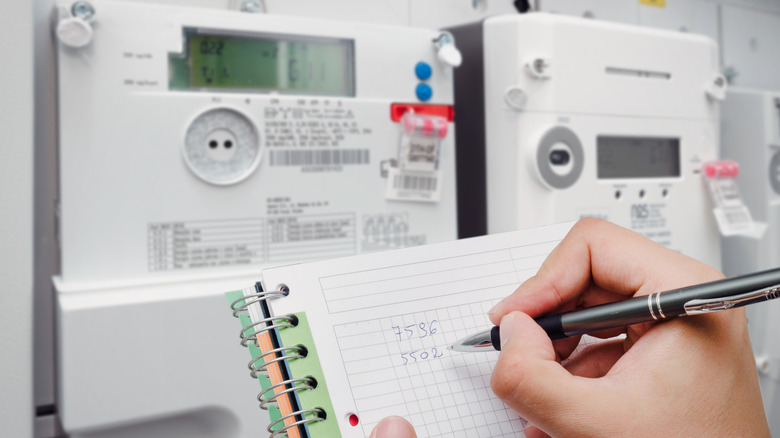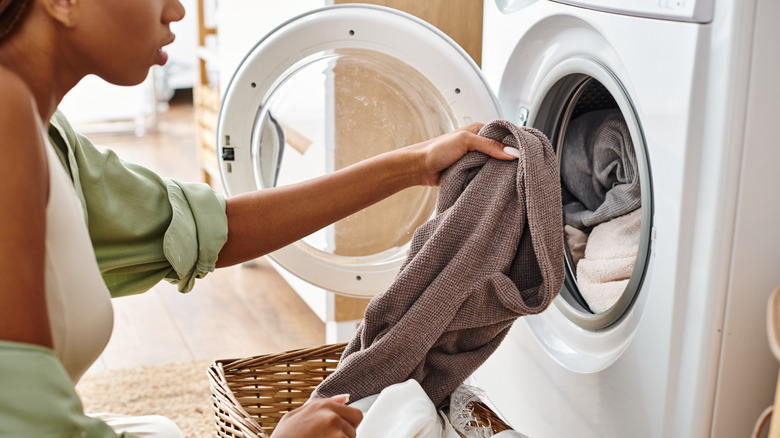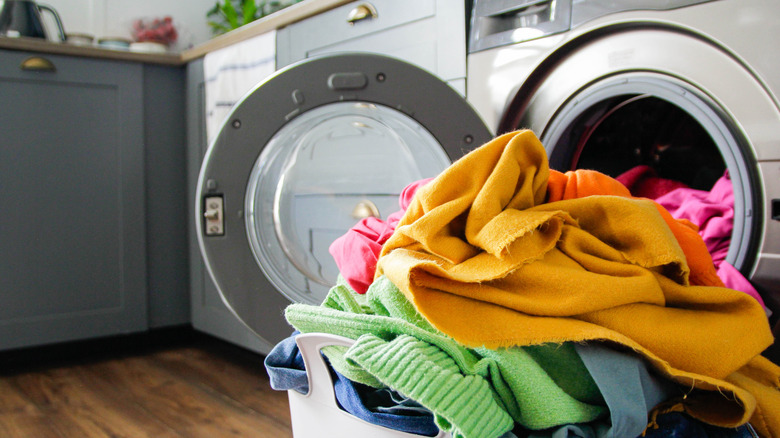Almost Every House Has This Appliance, And It's Using More Energy Than You Think
Across the world, the United States ranks at the top in terms of households that own a clothes dryer, with the figures standing at 80% of homes, much higher than any other country across Europe or Asia. With such high adoption, you might assume that their energy impact can't be that high. Well, the truth might surprise you. As of 2021, dryers alone were taking up 3.1% of the U.S. residential energy, which is over six times higher than washers. But it's not just the uptake that is stressing the grid, but also the pinch on an average consumer's wallet.
According to the U.S. Energy Information Administration, the total cost incurred by households stands at $7.69 billion. On a per-household basis, clothes dryers are responsible for approximately 6% of the total energy uptake. In terms of raw electrical power uptake, the annual 1,079 kWh per household figures for a clothes dryer are even higher than those for an air conditioner and twice that of a dishwasher. An investigation by the American Council for Energy-Efficient Economy also questions whether we know the true energy impact of dryers because not all dryers are made the same, and how their power uptake footprint varies. "These differences have been missed because the Department of Energy (DOE) test method measures energy consumption for only part of the drying cycle," says the report.
A hidden dark side with a simple solution
Over the years, researchers have also tested the current-gen dryers, studied their engineering, and made recommendations to boost their efficiency. The folks over at Oak Ridge National Laboratory, which runs under the aegis of the Energy Department and experiments with everything from EV wireless charging to advanced materials and computing, released a report on conventional clothes dryers in 2017 and also recommended steps to reduce their energy uptake as well as their emission footprint. The report notes that manufacturers should optimize the design of the heat exchanger and compressor, and avoid using active heat rejection systems in dryers. Doing so would yield performance as well as cost-related benefits.
"The manufacturing cost premium relative to conventional dryers was reduced by half," the report concludes following rigorous testing in their lab. The energy uptake of dryers is already a worrisome situation for households struggling with inflated bills, but there are a few other aspects that have concerned scientists for years. A lone dryer produces and dumps a staggering 120 million microfibers, according to estimates by experts at the University of Hong Kong.
Additionally, the sheer amount of power they suck from the energy grid each year, that power generation is also linked with the emission of 27 million tons of carbon dioxide. The solution? Go natural with line drying. Experts at the University of Michigan say that if we go all in with line drying, households can end up saving over $2,100 in energy costs, while also cutting down on the climate-devastating carbon dioxide emissions by 3 tons per home. On the more practical side, you can take a hybrid approach and still save a significant amount of money and cut down on harmful emissions.
The best way forward
When it comes to the operation of dryers, experts note that the thing that affects energy consumption and efficiency the most is how wet the clothes you're putting inside are. The higher the water content trapped between the fibers, the more energy it will take for the dryer to wring all the moisture out. Even though it's not a straightforward calculation, the added energy toll of heating can't be ignored. So, as a user who doesn't have the luxury of line drying, what's the best way forward?
The best step forward is to ensure that the clothes contain the lowest amount of moisture on their surface. To achieve that, increase the speed of the washer so that the maximum amount of water is extracted before you put the clothes in the dryer. Interestingly, the number games also play a key role. As long as you don't go beyond the loading capacity, try to reduce the number of batches. Simply put, go with a full load for drying, instead of multiple rounds with a smaller batch of clothes.
Another helpful operation tip is dialing down the heat level. "The clothes get just as dry, though drying time may be longer," concludes a lab-based analysis of dryers. Of course, before you purchase a dryer, go with the highest energy-saving tier possible. The Department of Energy has also explored tweaking the energy conservation standard applied to clothes dryers, which would result in energy, cost, and health benefits worth around $62.2 billion in the long run.


